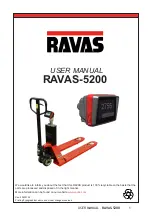
PAGE 4 OF 4
1114 IH-4709
OpeRATION CONTINUeD
STOPPING
Stop the truck as gradually as possible. Unnecessary
rapid stopping could be hazardous. Load could
become unstable.
To stop the truck's movement (forward or reverse), raise
the control handle to the up position or push the control
handle all the way down. In both positions, the electric
brake will deactivate and the brake will apply. To
release the brake, just move the control handle to the
operating position. (See Figure 5)
NOTe: The steering arm gas spring
automatically raises the steering arm to the
upright position when the steering arm is
released.
CAUTION! If the control handle does not raise
immediately to the vertical position when
released, the truck should be placed out of
service until it can be inspected by a qualified
service technician.
PARkING
When parking the truck, do not obstruct traffic lanes or
aisles.
1. Park the truck in its designated parking area.
2. Raise the steering arm until vertical to apply the
parking brake.
3. Fully lower forks.
4. Turn key switch to off position.
5. Remove key for added security.
6. Pull out battery disconnect.
LOAD HANDLING
WARNING! handle only loads arranged for
stability and always use caution. Raise and
lower the load smoothly to prevent the load
from falling.
WARNING! Always be sure the load and load
center are within the capacity of the truck. If in
doubt, check the nameplate.
1. Approach the load slowly.
2. Move the truck slowly into position so that the forks
are within pallet or skid, and the load is centered
over the forks and as far back as possible.
3. Raise the forks to lift load.
4. Lead the truck by the control handle with the load
trailing except when in confined areas. Ramps
should be traveled with operator uphill of truck when
empty, or operator downhill of truck with load on
forks.
5. Always look in the direction of travel. Move slowly
and check clearances when approaching
obstructions.
6. Do not make sudden starts and stops. Operate truck
smoothly and gradually.
7. Travel slowly and squarely around corners.
Remember that the trailing load wheels do not
follow the turn path of the drive wheel. Instead, they
tend to cut the corner.
8. Line up the truck with the unloading area.
9. Stop the truck and check the load alignment with
surrounding objects.
10. Be careful not to damage or move adjacent loads
and objects.
11. Lower the forks until the load is resting on its own.
12. Move the truck back until the forks are clear of the
pallet.
Figure 5
Brake
On
Brake
Off
Brake
On
π
CHICAGO • ATLANTA • DALLAS • LOS ANGELES • MINNEAPOLIS • NYC/PHILA • SEATTLE • MEXICO • CANADA
1-800-295-5510
uline.com




















